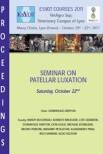OBJECTIVES: Comparison of PennHIP and a novel method to diagnose hip laxity, called the Vezzoni modified Badertscher distension device technique.
METHODS: In a total of 10 dogs, it was first assessed whether the distraction index (DI) from the PennHIP evaluation center could be reproduced by two individual observers. In the next two steps, the DI measurements made by the individual observers and the PennHIP evaluation center were compared with the laxity index (LI) measured on the Vezzoni modified Badertscher distension device view. Finally, the interobserver agreement of the DI, LI and Norberg angle was assessed and compared with classification criteria.
RESULTS: The results were similar for the first three comparisons: there was no evidence for bias, the relation between DI and LI was linear and the variability was small. A comparison of the interobserver agreement showed that the measurement variability for the NA was substantial, while the reproducibility for the DI and LI was equal.
CLINICAL SIGNIFICANCE: While the standard ventrodorsal hip extended radiograph is most commonly used for diagnosis and screening of canine hip dysplasia, it lacks sensitivity to diagnose laxity. To improve the identification of hip joint laxity, distraction-based radiographic techniques are helpful. The Vezzoni modified Badertscher distension device technique allows for a reliable in-house evaluation of canine hip joint laxity.









